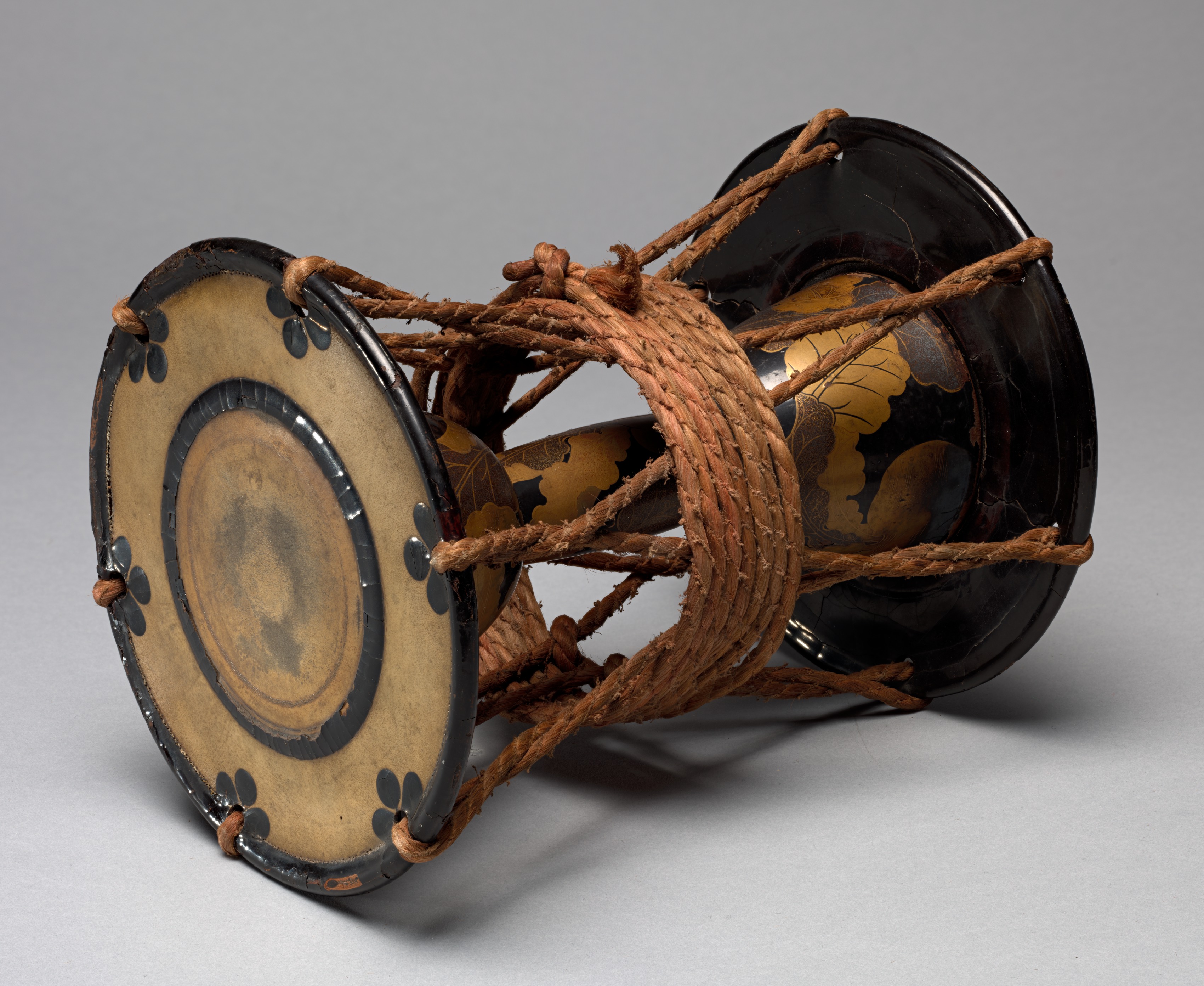The Cleveland Museum of Art
Collection Online as of April 24, 2024

Tsuzumi Drum
1800s
(1615–1868) to Meiji period (1868–1912)
Diameter: 20.4 cm (8 1/16 in.); Overall: 25.4 cm (10 in.)
Location: not on view
Description
Tsuzumi hand drums were used as musical accompaniment for formal theatrical productions such as Noh, but also in traditional folk music. Small tsuzumi like this one are set against one shoulder, and held in place with one hand, while the other hand beats the heads. The sound is adjusted by regulating the humidity of the hide with one’s breath or spittle.- The two-sided hand drum is made of wood, lacquer, gold leaf, animal skin, and a natural fiber rope. The central body of the drum is a hollow hourglass-shaped wooden structure that is lacquered and gilded. The two circular flat heads of the drum are lashed together with a fiber cord threaded through six holes along the head edges, and there is a central wrapping with the same cord that pulls the vertical cords taut. This would have been tightened or loosened by the drum’s user to adjust the tone. The two drum heads appear to be composed of a wooden ring that is wrapped in a flat fiber, over which a skin is stretched. The skin covers the entire top side, and is wrapped around the underside leaving a central opening into which the drum body fits. The skin is stitched on the top side around the inner circumference of the ring. The outer edge and underside of each head is lacquered, with three-petaled lacquer decorations around each of the six holes around the circumference. There is another lacquer ring encircling the central portion of the top of each drum head where it was struck during playing.
In 2018, the drum was treated for display. The skin of one of the drum heads was cracked and broken with numerous tears. This is likely a result of the drum being stored standing on one end, with the cords under tension, and undergoing changes in relative humidity over time. The lacquer overall was cracked and lifting, both on the drum heads and on the body. Lifting and cracked areas of lacquer on the drum head and body were adhered with collagen glue. A shimbari frame was built and used to assist with applying pressure to the curved drum surfaces. The drum strings were untied and loosened to allow access to the inner face of the torn drum head, which was repaired with Japanese kozo paper and adhesives. Losses in the lacquer rings on the drum heads were replaced with sections of cast epoxy resin, adhered with a reversible adhesive. A storage mount was designed to support the body of the drum so that it does not cause further distortion or damage to the drum heads, and the cordage was tied slightly more loosely to reduce tension. - ?–1915Collection of Charles G. King, Jr. [1860–1911], New York, NY, given to the Cleveland Museum of Art by his brother Ralph King1915–The Cleveland Museum of Art, Cleveland, OH
- "Accessions." The Bulletin of the Cleveland Museum of Art 5, no. 8/9 (1918): 82-85. Mentioned: p. 82 www.jstor.orgD. S. M. "Exhibition of Musical Instruments." The Bulletin of the Cleveland Museum of Art 8, no. 9 (1921): 134-43. Mentioned: pp. 134-137 www.jstor.org
- Japanese Gallery 235 Rotation. The Cleveland Museum of Art (organizer) (January 2-July 9, 2018).Exhibition of the Month: Music in Art. The Cleveland Museum of Art, Cleveland, OH (organizer) (October 2, 1945-February 4, 1946).
- {{cite web|title=Tsuzumi Drum|url=false|author=|year=1800s|access-date=24 April 2024|publisher=Cleveland Museum of Art}}
Source URL:
https://www.clevelandart.org/art/1918.349